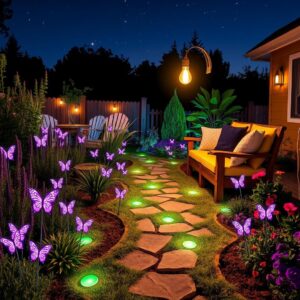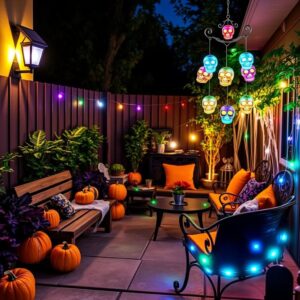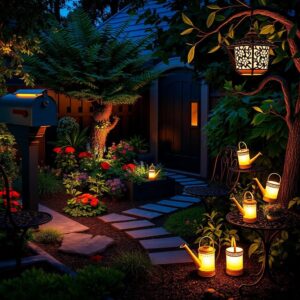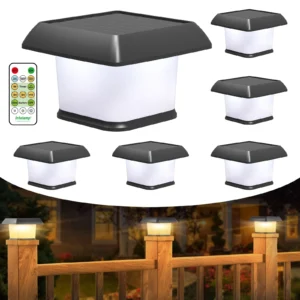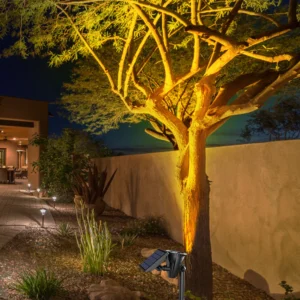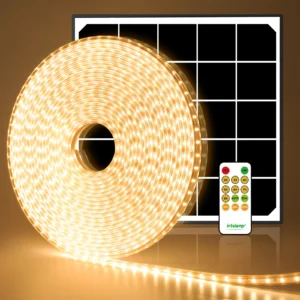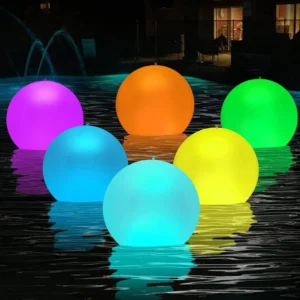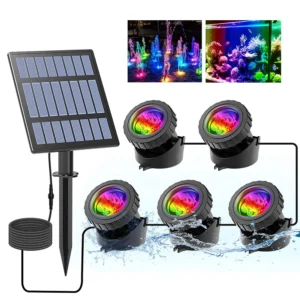When it comes to creating an inviting atmosphere around your swimming pool, solar pool lights play a crucial role. These innovative lights not only provide illumination but also enhance the overall aesthetic of your pool area. With various color options available—such as red, yellow, green, blue, purple, and white—solar pool lights can transform your space into a stunning visual experience. In this guide, we’ll explore how to select the best colors for solar pool lights, considering factors like color temperature and usage scenarios.
Understanding Color Temperature and Its Impact
Color temperature, measured in Kelvin (K), is a key factor in determining how different light sources affect the appearance and mood of a space. The Kelvin scale ranges from warm to cool tones, influencing everything from comfort levels to visibility. Understanding this scale is essential when selecting solar pool lights for your swimming area.
The Kelvin Scale Explained
Warm Colors (2000K to 3000K): Lights in this range emit a soft, yellowish glow, creating a cozy and inviting atmosphere. These colors are often associated with traditional incandescent bulbs and are ideal for spaces where comfort and relaxation are priorities. For example, solar pool lights with a color temperature of around 3000K can make your hot tub or spa area feel warm and welcoming, perfect for chilly evenings.
Neutral Colors (3000K to 5000K): This range includes warm white to cool white lights, which offer a balance between warmth and brightness. Neutral colors are versatile and suitable for various applications, providing clarity without harshness. They are commonly used in pool areas to enhance visibility while maintaining a pleasant ambiance.
Cool Colors (5000K to 6500K): Lights in this category produce a bright, bluish-white hue, similar to daylight. These colors are excellent for task-oriented spaces where clarity is essential, such as pathways or areas where safety is a concern. However, while cool lights can enhance visibility in and around your pool, excessive exposure to high color temperatures (above 6500K) can contribute to eye strain, especially in an outdoor environment where natural light is also present.
Effects on Mood and Atmosphere
The color temperature of your solar pool lights can significantly influence the mood of your outdoor space:
Warm Light: Often associated with relaxation and comfort, warm lights are perfect for evening gatherings, family time, or quiet moments by the pool. They create an inviting atmosphere that encourages people to linger and enjoy their surroundings.
Neutral Light: This lighting option is great for social events, as it provides clarity and vibrancy without being overly harsh. It helps maintain an energetic yet balanced environment, making it suitable for both daytime and evening activities.
Cool Light: While bright and energizing, cool lights can sometimes feel sterile or harsh. They are best used strategically in areas that require high visibility, such as around steps or deeper parts of the pool, ensuring safety while allowing for moments of brightness.
Choosing the Right Color Temperature
When selecting solar pool lights, consider how different color temperatures align with your desired atmosphere:
For Relaxation: Opt for warm colors (2000K to 3000K) to create a soothing environment in areas like spas or lounge spaces.
For Vibrancy: Choose neutral colors (3000K to 5000K) for social settings where clarity and warmth are both important.
For Safety: Use cool colors (5000K and above) in high-traffic areas or places requiring extra visibility, but be mindful of potential eye strain from prolonged exposure.
By understanding the effects of the Kelvin scale and selecting the appropriate color temperature for your solar pool lights, you can significantly enhance the overall experience of your outdoor space, ensuring it is both functional and inviting.
The Science Behind Light Penetration Underwater
When selecting solar pool lights, understanding how light behaves underwater is essential for creating an effective and visually appealing environment. The penetration and diffraction of light in water differ significantly from their behavior in air, influencing the visibility and ambiance of your pool area.
The Science of Light Diffraction
Light diffraction refers to the bending and spreading of light waves as they encounter obstacles or pass through openings. In the context of underwater lighting, this phenomenon is influenced by the properties of water as a medium, which affects how different colors of light are perceived.
How Light Diffuses in Water
Medium Differences: Light travels faster in air than in water. When light enters water, it slows down and bends, leading to a change in its path. This change can reduce the intensity of light as it penetrates deeper into the water, with certain colors dissipating more rapidly than others.
Wavelength Dependency: Different colors of light have varying wavelengths, which affects their ability to penetrate water. Generally, shorter wavelengths (such as blue and violet) have more energy and can penetrate water more effectively. However, while they may travel further, they often lack the brightness needed for effective illumination at greater depths.
Longer Wavelengths: Colors like red and orange have longer wavelengths and are more susceptible to diffraction. They tend to disperse quickly and lose intensity as they travel through water. While red light can create a warm ambiance, it is less effective for illuminating larger areas of a pool compared to shorter wavelengths.
Implications for Solar Pool Lighting
Understanding these principles is crucial when selecting the color of your solar pool lights:
Choosing the Right Color: For optimal underwater visibility, colors with shorter wavelengths, such as blue and green, are often preferred. These colors can penetrate water more effectively, maintaining their intensity even at greater depths. Blue light, for example, mimics the natural hues of oceans and lakes, creating a visually appealing effect in the pool.
Maximizing Effectiveness: Combining colors can enhance visual appeal and functionality. For instance, using a combination of blue and yellow lights can create a dynamic and vibrant atmosphere while ensuring adequate visibility. This combination can enhance the overall aesthetic while providing a safe swimming environment.
Practical Applications in Pool Design
When designing your pool area with solar lights, consider how the diffraction of light can enhance your space:
Layering Lights: Use a mix of colors at different depths and angles. This layering approach can help create a more immersive atmosphere while ensuring that all areas of the pool are adequately illuminated.
Focusing on Key Areas: Direct brighter lights (such as blue or white) towards areas that require more visibility, like steps or deeper sections. Meanwhile, use warmer colors in lounging areas to create a relaxing ambiance.
Practical Applications: Choosing Colors for Various Scenarios
Choosing the right color for solar pool lights involves considering how each color can enhance various activities and atmospheres in your pool area. Different colors evoke distinct feelings and serve unique purposes, making it essential to align your lighting choices with the intended use of your pool. Here are some practical recommendations for selecting light colors based on specific usage scenarios:
1. Relaxation Zones: Yellow and Warm White Lights
Recommendation: Yellow and Warm White Lights (2000K – 3300K)
- Purpose: Ideal for spa areas, relaxation zones, and cozy outdoor settings.
- Benefits: Yellow and warm white lights create a soothing ambiance that promotes relaxation. These colors are inviting and comfortable, perfect for late-night swims or unwinding after a long day.
- Practical Application: Use yellow lights around hot tubs or spa sections to enhance the feeling of warmth and comfort. Warm white lights can be incorporated throughout lounging areas to create a cozy atmosphere.
2. Social Spaces: Neutral Lights
Recommendation: Neutral White Lights (3000K – 5000K)
- Purpose: Suitable for social gatherings, parties, and outdoor events.
- Benefits: Neutral white lights provide a bright and vibrant atmosphere without being harsh. They enhance visibility while maintaining an inviting environment.
- Practical Application: Place neutral lights around the pool area, including seating spaces and dining tables, to ensure guests feel comfortable while enjoying conversations and activities.
3. Safety and Visibility: Cool White and Blue Lights
Recommendation: Cool White and Blue Lights (5000K – 6500K)
- Purpose: Excellent for high-traffic areas, steps, and safety zones.
- Benefits: Cool white and blue lights offer high visibility, making them perfect for areas where safety is a priority. These colors help swimmers navigate the pool, especially during nighttime.
- Practical Application: Install cool white lights along pool edges, steps, and shallow areas to ensure that all spaces are well-illuminated and safe for use. Blue lights can also be strategically placed to enhance visibility while creating a refreshing atmosphere.
4. Party Atmosphere: Purple and Color-Changing Lights
Recommendation: Purple and Color-Changing Lights
- Purpose: Great for festive events, parties, and gatherings.
- Benefits: Purple lights add an element of excitement and enchantment, making them ideal for celebrations. Color-changing lights can create dynamic effects, adapting to different moods throughout the event.
- Practical Application: Use purple lights to set a lively mood for pool parties or nighttime events. Consider installing color-changing solar lights that shift hues, allowing guests to experience a variety of atmospheres throughout the evening.
5. Tropical Vibe: Green Lights
Recommendation: Green Lights
- Purpose: Perfect for creating a tropical or nature-inspired ambiance.
- Benefits: Green lights symbolize vitality and life, enhancing the feeling of being in a lush, outdoor paradise. They can evoke feelings of happiness and relaxation, reminiscent of tropical getaways.
- Practical Application: Incorporate green lights around landscaping features, such as plants and garden beds, to create a cohesive tropical theme. Pair them with blue lights in the pool to mimic the colors of the ocean and enhance the overall aesthetic.
Conclusion
Selecting the right colors for your solar pool lights can significantly enhance the ambiance of your swimming area. By considering color temperature, light penetration, and specific usage scenarios, you can create the perfect atmosphere for relaxation, fun, or a tropical getaway. Explore the various lighting colors available to enrich your pool experience and enjoy every moment by the water!


